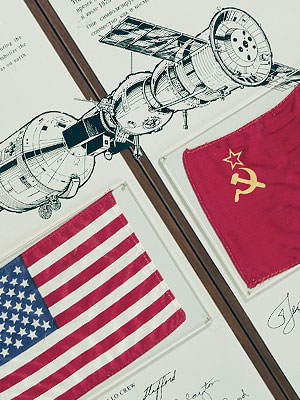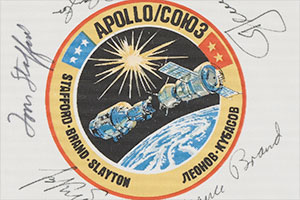July 14, 2025 — They were among the last items to be cleared for flight on a high-profile space mission that was already packed with ceremonial mementos.
On June 27, 1975, then-NASA Administrator James Fletcher wrote a memo to John Yardley, the agency's head of human space flight, asking him to "make arrangements" to include two bicentennial lapel pins aboard the command module set to lift off on the Apollo-Soyuz Test Project (ASTP), the first joint mission with Russia (then, the Soviet Union). It was just 19 days before the scheduled liftoff of what would be the last crewed flight before the U.S. celebrated its 200th birthday the next year.
Launched seven hours apart on July 15, 1975, the three American astronauts — Thomas Stafford, Vance Brand and Donald "Deke" Slayton — on board the Apollo command module and two Russian cosmonauts — Alexei Leonov and Valery Kubasov — on a Soyuz spacecraft met up in orbit for a history-making handshake between the Cold War and space race rivals.
Whether it was an oversight or a last-minute opportunity that the bicentennial pins became a late addition is unknown, as is where those two pins are today. It is not clear if the pins even made it into the "Official Flight Kit" or OFK, the pouch aboard the command module that held trinkets and commemorative items.
The OFK manifest — published here for the first time online, along with the contents of the three U.S. crew members' preference kits — does not list a pair of bicentennial pins. The only pins included in the inventory are two for Oklahoma (on behalf of Senator Dewey Bartlett) and "fifteen (15) sets of wings and pins" for the prime, backup and support crews.
The same goes for two other items that Fletcher approved three days after the pins: presidential and vice presidential flags. Like the pins, the banners are not listed on the manifest as archived by NASA, but in the flags' case, there is photo documentation that they did fly. The astronauts — Stafford, Brand and Slayton — gifted Gerald Ford with the presidential flag during a well-covered ceremony in the White House Rose Garden on Aug. 9, 1975.
Preparations for the ASTP OFK began three months before the mission's launch when the Astronaut Office submitted its request for items to be flown. Most of what was on that list made it on board, as reflected by the later-issued manifest, but not all. The original ask included more than 20 medium-size (5 by 8 inch or 13 by 20 centimeter) American flags to be presented post-flight to the mission's contractors and supporting NASA field centers, as well as the crew's birth states, home towns and schools.
The OFK manifest lists no flags of that size,, but the number of small United States flags (3 by 5 inches or 8 by 13 cm) flown on the mission was increased to 2,000 over the initial count of 1,560.
Separate to all of these items were commemorative pieces and mementos that were displayed or exchanged between the U.S. and Soviet crew members during the mission. The items in the OFK and APKs (astronaut preference kits, later to be called personal preference kits, or PPKs) were stowed and left untouched until after the flight.
Today, 50 years later, the contents of the Apollo-Soyuz Test Project Official Flight Kit (and the astronauts' preference kits) have mostly, if not all been distributed to their intended recipients. After distributing the small American flags as mementos of the mission (including some double mounted with one of the 300 Soviet flags flown in the OFK), NASA began using the remaining banners as retirement gifts for employees who made "outstanding contributions" to the Apollo, Skylab, ASTP and early space shuttle programs.
A pair of the U.S. and USSR flags flown on ASTP that was presented to the congressman Carl Albert, the Speaker of the House of Representatives in 1975, is currently up for auction by Sotheby's in New York, offered together with other Apollo-Soyuz memorabilia from his estate. Sotheby's estimates the lot will sell for $5,000 to $7,000 (at the time this article was written, the high bid was $4,000).
Update: Sotheby's sold the Apollo-Soyuz Test Project mementos lot for $13,970. |
|

United States and Soviet Union flags that were flown on the Apollo-Soyuz Test Project (ASTP) inside the 1975 mission's Official Flight Kit (OFK) aboard the Apollo command module. (Sotheby's)

A late addition to the Official Flight Kit, a presidential flag flown on the Apollo-Soyuz Test Project was presented to Gerald Ford by the U.S. crew at the White House on Aug. 8, 1975. (NARA)

One of 400 Beta cloth Apollo-Soyuz Test Project (ASTP) mission patches that were inside the Official Flight Kit (OFK). It was later signed by the U.S. and Soviet crew members. (Heritage Auctions) |
